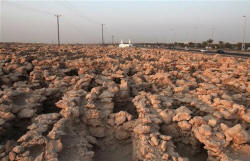|
 Bahrain history slowly rises from sands Bahrain history slowly rises from sands
 Send a link to a friend
Send a link to a friend
[August 03, 2013]
SAAR, Bahrain
(AP) -- More than 4,000 years ago, Dilmun merchants traveled from Mesopotamia to the Indus River, titans of trade and culture before rise of the empires of the Persians or the Ottomans
|
|
 Over a millennia, the civilization that Dilmun created on the back of trading in pearls, copper and dates as far as South Asia faded into the encroaching sands. It wasn't until an excavation by Danish archaeologists in the 1950s that its past was rediscovered. Over a millennia, the civilization that Dilmun created on the back of trading in pearls, copper and dates as far as South Asia faded into the encroaching sands. It wasn't until an excavation by Danish archaeologists in the 1950s that its past was rediscovered.
Now, with Bahrain in a deepening political crisis between its Sunni rulers and majority Shiite population, the connection to ancient Dilmun is one of the few unifying symbols on the island. It also is a rare and vivid look at pre-Islamic life in a region with few sites celebrating cultures before the time of the Prophet Muhammad.
A distinguishing feature of Dilmun civilization was extensive burial mounds, which are still visible today
-- but under threat.
In the ancient settlement of Saar, about 10 kilometers (six miles) southwest of Bahrain's capital, Manama, archaeologist and researcher Abdul Aziz Suwalih worries about modern developments that have chipped away at the honeycomb-patterned burial mounds. The mounds have been proposed as a UNESCO World Heritage site to join Bahrain's ancient Dilmun harbor on the list.

"Bahrain was famous for holding the largest cemetery in the world by having more than 100,000 burial mounds. Now we have around 60,000 burial mounds. There are threats," Suwalih told The Associated Press. "Protecting the archaeological sites in Bahrain is a big issue."
[to top of second column] |
 In May, Bahrain hosted a conference by UNESCO
-- the U.N.'s educational, scientific and cultural body -- that included discussions about preserving the burial mounds and other remnants of Dilmun civilization, as well as prospects for future digs and explorations.
The Saar settlement was excavated between 1990 and 1999 by the London-Bahrain Archaeological Expedition, though more work remains.
"It is the only Dilmun settlement that has been extensively investigated by archaeologists," Suwalih said.
There are more than 70 buildings in the settlement, some of which were extraordinarily well-preserved and showcases domestic life and worship in a society that followed the rhythms of the moon. Here's a gallery of images from archeological sites in the ancient settlement of Saar in modern-day Bahrain.
[Associated
Press; By REEM KHALIFA]
Follow AP photographers
and photo editors on Twitter:
http://apne.ws/15Oo6jo.
Copyright 2013 The Associated
Press. All rights reserved. This material may not be published,
broadcast, rewritten or redistributed.
|